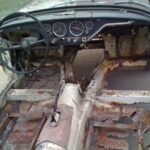Car diagnostic tests have become an indispensable part of modern vehicle maintenance. If you’ve ever seen the check engine light illuminate or experienced unusual vehicle behavior, a diagnostic test is often the first step towards identifying the problem. But a common question arises for many car owners: does a car have to be on for a diagnostic test? Let’s delve into the world of car diagnostics to clarify this and understand what these tests can reveal about your vehicle’s health.
Decoding Car Diagnostic Tests
Think of a car diagnostic test as a health check for your vehicle, but instead of a stethoscope, technicians use sophisticated digital tools. Modern cars are equipped with complex computer systems that monitor and control various components, from the engine and transmission to the brakes and emissions systems. When something malfunctions, these systems generate error codes, essentially digital signals indicating a problem.
A diagnostic test involves connecting specialized scanning tools to your car’s On-Board Diagnostics (OBD-II) port, typically located under the dashboard. These tools communicate with your car’s computer, retrieving stored trouble codes and live data from various sensors. Professional auto repair shops, like Professional Auto Repair, utilize advanced diagnostic equipment, ensuring accurate and efficient problem identification.
Does the Engine Need to Be Running for a Diagnostic?
Now, back to the core question: does the car have to be running to perform a diagnostic test? The answer is not always a simple yes or no. It depends on what information is being accessed and the capabilities of the diagnostic tool being used.
For basic code reading and system checks, the engine does not necessarily need to be running, but the ignition usually needs to be in the “ON” position. This position powers up the car’s computer systems, allowing the diagnostic tool to communicate and retrieve stored codes and some live data. In many cases, a diagnostic scan can be initiated with just the key turned to the “ON” position without starting the engine.
However, for more comprehensive diagnostics, especially when assessing real-time performance issues or intermittent problems, running the engine is often necessary. Live data streaming, which provides readings from sensors while the engine is operating, can be crucial for diagnosing issues related to engine performance, fuel delivery, emissions, and more. This dynamic data can reveal problems that might not be apparent when the engine is off.
Furthermore, certain diagnostic procedures, particularly those involving component testing or in-depth system analysis, may require the engine to be running to properly evaluate the system under normal operating conditions.
What Information Can a Diagnostic Test Uncover?
Regardless of whether the engine is running or just the ignition is on, a car diagnostic test offers a wealth of information about your vehicle’s condition. It goes far beyond just reading trouble codes. A comprehensive diagnostic test can provide insights into:
- Engine Performance: Identify issues with fuel injectors, airflow sensors, ignition coils, and other engine components.
- Transmission System: Detect problems within the automatic or manual transmission, including shift solenoid issues or fluid pressure irregularities.
- Emissions System: Pinpoint malfunctions in catalytic converters, oxygen sensors, and other emission control devices, ensuring your car is environmentally compliant.
- Brake System: Assess the Anti-lock Braking System (ABS) and traction control systems for faults.
- Electrical System: Diagnose problems with sensors, actuators, and wiring harnesses throughout the vehicle.
- Vehicle Health Monitoring: Provide data on fuel efficiency, overall system performance, and identify potential issues before they escalate into major repairs.
By identifying problems early, diagnostic tests can prevent minor issues from becoming costly repairs down the line. Regular diagnostic checks can also contribute to better fuel economy and reduced emissions, keeping your car running efficiently and responsibly.
When is the Right Time for a Diagnostic Test?
Knowing when to schedule a diagnostic test is key to proactive vehicle maintenance. Consider a diagnostic check in these situations:
- Check Engine Light is On: This is the most obvious indicator that your car’s computer has detected a problem. A diagnostic test will pinpoint the cause.
- Performance Issues: If you notice a decrease in power, rough idling, unusual noises, or changes in fuel economy, a diagnostic test can help identify the underlying cause.
- Routine Maintenance: Even without apparent problems, a yearly diagnostic test as part of your regular maintenance schedule can uncover hidden issues and ensure your vehicle is in optimal condition.
- Before Long Trips: To ensure peace of mind and prevent breakdowns, it’s wise to get a diagnostic check before embarking on extended road journeys.
- After Repairs: Following significant repairs, a diagnostic test can verify that the repairs were successful and that no related issues have arisen.
Conclusion: Proactive Diagnostics for Vehicle Longevity
In conclusion, while a car doesn’t always have to be fully running for a diagnostic test, having the ignition in the “ON” position is generally required for basic scans, and running the engine is often essential for more in-depth analysis and live data readings. Car diagnostic tests are powerful tools that provide invaluable insights into your vehicle’s health. By utilizing these tests proactively, you can ensure your car operates efficiently, prevent costly repairs, and maintain its longevity. Don’t wait for warning lights to appear – schedule a diagnostic test at Professional Auto Repair today to keep your vehicle performing at its best and address any potential issues early on.
Are you looking for reliable auto repair services? Contact Professional Auto Repair to schedule your diagnostic test and ensure your vehicle is running smoothly and efficiently.


